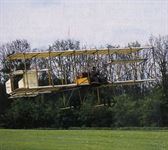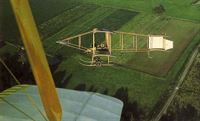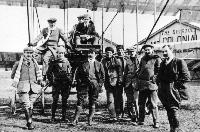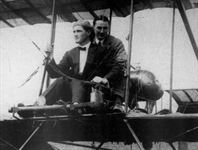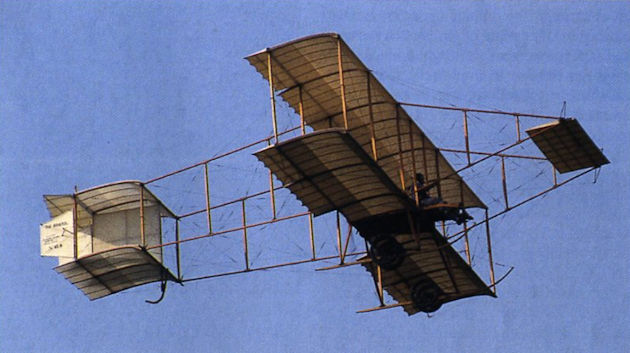
Описание
Страна : Великобритания
Год : 1910
Двухместный учебно-тренировочный самолет
Bristol Boxkite
В 1909 году сэр Джордж Уайт, миллионер родом из Бристоля, сделавший хороший бизнес на использовании трамваев в качестве городского транспорта, решил, что создание самолетов достигло той стадии практического развития, когда крупные инвестиции могут принести немалые дивиденды. К тому времени существовало две британские авиакомпании - "Short Brothers" и "Handley Page Ltd", работу которых Уайт тщательно проанализировал и сделал вывод, что деятельность этих компаний, а также ряда менее известных предприятий и организаций основана скорее на энтузиазме, чем на финансовых расчетах, особенно в плане капитализации.
В феврале 1910 года Уайт с сыном и братом создали четыре компании: "Bristol Aeroplane Co. Ltd", "Bristol Aviation Co. Ltd", "British and Colonial Aeroplane Co. Ltd" и "British and Colonial Aviation Co. Ltd". Первые две и последняя из них были созданы на перспективу, в то время как третья компания должна была приступить к работе незамедлительно.
Было решено, что новая компания займется поначалу выпуском по лицензии продукции других компаний, - предпочтение было отдано французскому биплану с толкающим винтом Zodiac, сконструированному Габриелем Вуазеном. Однако первому самолету этого типа так и не удалось подняться в воздух, и договор был расторгнут, после чего компания "Bristol" решила заняться созданием собственного самолета. Он был разработан на базе биплана Генри Фармана с толкающим винтом и оснащался двигателем компании "Gnome", причем фирме "Bristol" удалось стать единственным агентом компании "Gnome" в Великобритании и всех частях Британской Империи.
Первым самолетом новой компании, известной под названием "Bristol", стал Bristol Boxkite (другое обозначение - 1910 Biplane). Первый экземпляр изначально оснащался четырехцилиндровым двигателем Gregoire мощностью 50 л.е., оказавшимся ненадежным и недостаточно мощным. После этого самолет получил двигатель Gnome мощностью 50 л. с. Первый успешный полет состоялся 30 июля 1910 года в Ларкхилле. Второй экземпляр имел восьмицилиндровый двигатель ENV мощностью тоже в 50 л. с. Этими самолетами первоначально были оснащены созданные летные школы компании "Bristol" в Бруклендс и Ларкхилл. Четыре других Boxkite были отправлены морем попарно в Австралию и Индию, куда они прибыли в декабре 1910 года. Первым заказом иностранного государства стал заказ России на восемь Boxkite, которые были поставлены в апреле 1911 года, - самолеты были оснащены двигателями Gnome мощностью 70 л. с. и имели увеличенные топливные баки, больший размах крыла и три руля направления.
Первый официальный заказ британского правительства был сделан на четыре самолета, два из них оснащались двигателем Gnome мощностью 50 л. е., другие два - двигателем Renault мощностью 60 л. с. Эти самолеты были переданы во 2-ю (аэропланную) роту воздухоплавательного батальона британской армии, сформированную 1 апреля 1911 года и базировавшуюся в Ларкхилле. Два более ранних Boxkite, один с двигателем Gnome мощностью 70 л. е., использовались в авиации британского флота, причем британское Адмиралтейство заказало еще шесть самолетов для обучения.
В целом было построено 76 Boxkite - все, за исключением шести, в Филтоне; а эти шесть были первыми самолетами, собранными на заводе в Брислингтоне.
ТАКТИКО-ТЕХНИЧЕСКИЕ ХАРАКТЕРИСТИКИ
Bristol Boxkite
Тип: двухместный учебно-тренировочный самолет
Силовая установка: один ротативный двигатель Gnome мощностью 50 л. с. (37 кВт)
Летные характеристики: максимальная скорость на уровне моря 64 км/ч
Масса: пустого 408 кг; максимальная взлетная 522 кг
Размеры: размах крыла 14,17 м; длина 11,73 м; высота 3,61 м; площадь крыльев 48,03 м2
- Описание
Фотографии
-
Air International 2000-03 / D.Baker - Reaching Those Parts That Others Can't /Technology/
Pioneering aviators were largely ignorant of the laws of stability and control and really did fly ‘by the seat of their pants’. Their task was not eased by the aircraft of the day which, like this Bristol Boxkite, were often unstable and underpowered.
-
Мировая Авиация 84
В безветренную ясную погоду Фонд устраивает полеты некоторых хрупких самолетов коллекции, включая реплику Bristol Boxkite, построенную для съемок фильма "Воздушные приключения".
-
Aeroplane Monthly 1996-12
Bristol Boxkite replica BAPC-2 / G-ASPP is one of three Shuttleworth Collection aircraft depicted on the new range of watches produced by London-based Watch Is It.
-
Aeroplane Monthly 1999-09 / M.Vines - Photo Masterclass /Aviation photography/ (3)
The Bristol Boxkite replica, here flown by the late Neil Williams, cruises at about 30 m.p.h. The only way to obtain a shot from the photo Tiger Moth was to fly on the outside of a very wide banked-in 360° circuit with the Boxkite on the inside, which enabled the Tiger to fly slightly faster and keep off the stall.
-
Aeroplane Monthly 1994-11 / M.Bowman - Golden Shuttleworth
A golden line-up of Shuttleworth Collection machines: the Bristol Boxkite and Avro Triplane replicas in company with a 1902 Baby Peugeot (foreground) and an 1898 Panhard Levassor, Richard Shuttleworth's first vintage car, which he entered in the 1929 London-Brighton run.
Другие самолёты на фотографии: Avro Triplane IV - Великобритания - 1910
-
Aeroplane Monthly 1974-08 / ??? - Boxkite flying hints
The Shuttleworth Trust's Bristol Boxkite replica flying at Old Warden.
-
Air Enthusiast 1972-02 / L.Coombs - Front-office evolution (1)
A Bristol Boxkite replica, in which the pilot had no protection at all.
-
Flight 1937-05 / Flight
Bristol beginnings are shown here, which shows Graham Gilmour flying a Bristol "Box-kite" from the Haslar sea wall in 1911.
-
Aeroplane Monthly 1977-07 / C.Winchester - Nostalgia Aeronautical
The Shuttleworth Trust's Bristol Boxkite reproduction catches the sunlight at Old Warden, October 31, 1976.
-
Aeroplane Monthly 1982-06
The Shuttleworth Bristol Boxkite reproduction taking off from Old Warden on August 30, 1981.
-
Aeroplane Monthly 1984-08 / D.Higgs - Go Shoot Yourself!
A striking perspective of Shuttleworth's Bristol Boxkite. The camera was mounted on the front port outer interplane strut!
-
Flight 1932-05 / Flight
AN EARLY "PUSHER": One of the Bristol "Box Kites" with Gnome rotary engine, on which many early pilots were trained.
-
Aeroplane Monthly 1986-04 / W.Morse - The Rotary Revolution (2)
Bristol Boxkite No 12A of 1911, fitted with a 50 h.p. seven-cylinder Gnome Omega.
The first Bristol aeroplane was the Box Kite, with 50 h.p. Gnome engine. 1910 -
Flight 1939-03 / Flight
Early streamlining: a “Box Kite” with a cowling over the pilot’s legs.
-
Мировая Авиация 74
Самолеты Boxkite применялись в собственных летных школах компании "Bristol", а также использовались в качестве учебных в британских ВМС. Адмиралтейство разместило свои машины в Истчерче, Чингфорде и на других авиабазах флота.
-
Air Enthusiast 2003-03 / P.Hare - That 'ban'
Bristol Boxkite at Point Cook, Australia in 1914, demonstrating its very thin wing.
-
Flight 1940-02 / Flight
AN EARLY MILITARY MACHINE: THE BRISTOL "BOX KITE" RESEMBLED IN A GENERAL WAY THE FARMANS OF THE SAME PERIOD. IT WAS FITTED WITH A GNOME ROTARY ENGINE DRIVING A PUSHER AIRSCREW. MANY EARLY PILOTS WERE TRAINED ON THIS TYPE OF MACHINE.
-
Flight 1935-05 / Flight
A Bristol "Box kite," also with Gnome engine. In this machine the occupants were unprotected.
-
Aviation Historian 6 / F.Merriam - Early Days at Eastchurch /Echoes from Dawn Skies/ (1)
Flying “straights” over the banked racing circuit at Brooklands, Surrey, on a Bristol Boxkite in 1911.
-
Aeroplane Monthly 1984-12 / ??? - Ancient and Modern
A Bristol Boxkite passes over Stonehenge at sunrise on June 21, 1913.
-
Flight 1930-01 / Flight
A cross-country race in progress at Brooklands during the summer of 1913
Другие самолёты на фотографии: Farman Farman-IV - Франция - 1910
-
Flight 1939-03 / Flight
The first Bristol aeroplane - the “Box Kite,” with 50 h.p. Gnome rotary engine, constructed by the British and Colonial Aeroplane Co., which eventually became the present Bristol Aeroplane and Motor Co. They were very similar to the Henry Farman, and large numbers were built and used for training purposes.
-
Flight 1929-11 / Flight
A LINK WITH THE PAST. When I was turning out some drawers the other day the enclosed photo came to light. Perhaps it may be of interest to you.
One fine July morning in 1911, and about 7 a.m., some of us, students, who were on the top floor of the Agricultural College at Uckfield, Sussex, were surprised to hear, what was then, the unaccustomed noise of two rotary motors. Looking out of a window we saw two biplanes, one of which is the subject of the photograph. This one promptly did a forced landing in a field nearby. Its pilot and passengers sitting "pick-a-back" were Messrs. Pizey and Fleming. The accompanying machine, a Bristol of the same type, and piloted solo by Mr. Gordon England, whose flying kit consisted of a cap reversed and an ordinary lounge suit with layers of newspaper under the waistcoat (!) did a perfect landing on Uckfield recreation ground at rear of college. Our principal invited the airmen to have breakfast at the college, which they did, and later in the day we had the pleasure of repairing parts of the damaged left wing in the carpenter's shop. This repair was apparently sufficiently airworthy to allow of the machine being flown away the next morning.
A. BERTOLACCI, Worthing. late R.A.F. November 18, 1929. -
Jane's All the World Aircraft 1980 / Encyclopedia of Aviation - Aircraft A-Z - v2
Bristol Boxkite подготовлен к полету в Салисбери-Плэйн, маневры британской армии в сентябре 1910 года. Данный самолет выполнил первый полет в Великобритании в военных целях, произведя в ходе учений разведку.
Bristol Boxkite before a demonstration flight in November 1910. -
Air-Britain Archive 1983-04
A Flanders monoplane of the Vickers School at Brooklands. In the background is a Boxkite of the Bristol School.
Другие самолёты на фотографии: Flanders F2 / F3 / F4 - Великобритания - 1911
-
Jane's All the World Aircraft 1980 / Encyclopedia of Aviation - Aircraft A-Z - v2
Bristol (Prier) monoplanes and Bristol Boxkites at the Bristol Flying School at Larkhill on Salisbury Plain in 1911.
Другие самолёты на фотографии: Bristol Prier monoplane / P-1 - Великобритания - 1911
-
Flight 1939-03 / Flight
Early aviation in India; a Bristol “Box Kite” was demonstrated in 1911 by Henri Jullerot.
-
Мировая Авиация 91
Bristol Boxkite представлял собой облагороженную копию биплана Анри фармана с мотором Gnome мощностью 50 л.с. На снимке: лейтенанта Эрика Харрисона поздравляет армейский офицер после полета 1 марта 1914 года на Boxkite.
-
Aviation Historian 29 / G.White - The world's first..?
Henri Jullerot sits at the controls of a Bristol Boxkite with Stanley White perching on the wing beside him, on the occasion of a flight from Durdham Down in Bristol in November 1910. Jullerot had joined the company as a test pilot shortly before, and was despatched to India with two Boxkites as a demonstration pilot that December.
-
Aviation Historian 7 / F.Merriam - "All very Wicked and Improper..." /Echoes from Dawn Skies/ (2)
Eric Gordon England seated at the controls of a Bristol Box kite at the same company’s flying school at Larkhill on Salisbury Plain, where he was an instructor. Other notable early aviators here are, from left, standing: Lt Ercole; Lt Antonini; Sehor Campana; Lt Moore RN; Lt Bower RN: Lt Athol Wyness-Stuart; Pierre Prier and Henri Jullerot.
-
Aviation Historian 7 / F.Merriam - "All very Wicked and Improper..." /Echoes from Dawn Skies/ (2)
England (nearest camera) and two colleagues pose with a Bristol Boxkite.
-
Aviation Historian 13 / F.Merriam - "Air-Itis" /Echoes from Dawn Skies/ (8)
Merriam (standing with arms crossed) and some of his early pupils with a Bristol Boxkite at Brooklands in 1911. Sitting in the pilot’s seat is fellow Bristol flying school instructor Collyns Pizey, who took Merriam for his first flight. In 1913 Pizey was appointed to the British Naval Mission to Greece, where he died of dysentery in 1915.
-
Aviation Historian 13 / F.Merriam - "Air-Itis" /Echoes from Dawn Skies/ (8)
Perched among copious struts and wires, Merriam poses in a Bristol Boxkite at Brooklands in 1911. TOP RIGHT Merriam’s 1914 Royal Aero Club Competitors’ Register Certificate for air-racing.
-
Aeroplane Monthly 1983-10 / L.Coombs - Cockpits of the RAF (1)
The Bristol Boxkite was typical of the early pusher biplanes without cockpits. It had conventional rudder pedals and a side-mounted stick (there is nothing new ...).
-
Aviation Historian 13 / F.Merriam - "Air-Itis" /Echoes from Dawn Skies/ (8)
Teaching an old dog new tricks - Frederick Warren Merriam (left) and fellow aviation pioneer Harold Barnwell with furry friend in a Bristol Boxkite at Brooklands. Merriam's own caption to the photograph reads: “First bulldog to fly, 1912. Barnwell holding the dog while I piloted. It is generally known that once a bulldog digs his teeth into one it doesn’t let go... this was in my mind and although rather restless at first he soon got used to the sensation and seemed to enjoy his novel experience”.
-
Air International 1983-01 / M.Hirst - Sight for blind men /Avionics analysed/ (1)
During trials on Salisbury Plain on 27 September 1910, Robert Loraine sent a morse wireless message "Enemy in sight" while flying a Bristol Boxkite. It was received over a quarter of a mile away. The only earlier recorded airborne wireless transmission took place one month before, in Canada.
-
Aeroplane Monthly 1974-08 / ??? - Boxkite flying hints
Close-up of the "drivers" seat on a "period" Bristol Boxkite. The engine is a 50 h.p. Gnome rotary.
-
Aeroplane Monthly 1986-04 / W.Morse - The Rotary Revolution (2)
Gnome applications. The 1911 Bristol Boxkite used a 50 h.p. Omega driving a pusher propeller.
-
Aeroplane Monthly 1982-09 / B.Gunston - The classic aero engines (1)
Standard power for the Bristol Boxkite was the 50 h.p. Gnome.
-
Aviation Historian 13 / F.Merriam - "Air-Itis" /Echoes from Dawn Skies/ (8)
Frederick Warren Merriam, one of Britain’s original "magnificent men”, beside a Bristol Boxkite at Larkhill in 1913.
-
Aeroplane Monthly 1982-07 / Painted Wings
Ray Tootall’s evocative portrayal of a young woman about to make a passenger flight in a Boxkite, possibly at Hendon.
-
Aeroplane Monthly 1978-07 / Painted Wings
An appealing study of a Bristol Boxkite entitled On Gossamer Wing, painted by Alan Feamley.
-
Flight 1939-10 / Flight Advertisements
Here’s one of the pioneer planes that used to attract such eager crowds during the summer of 1912. It is conducting some early wireless tests from the air. Even then (while airmen were still blazing a sky trail across the counties) Marconi service was planning ahead; foreseeing developments in the future. To-day, when air routes take a continent in their stride, naturally it is still Marconi Wireless Equipment that leads the way.
- Фотографии


